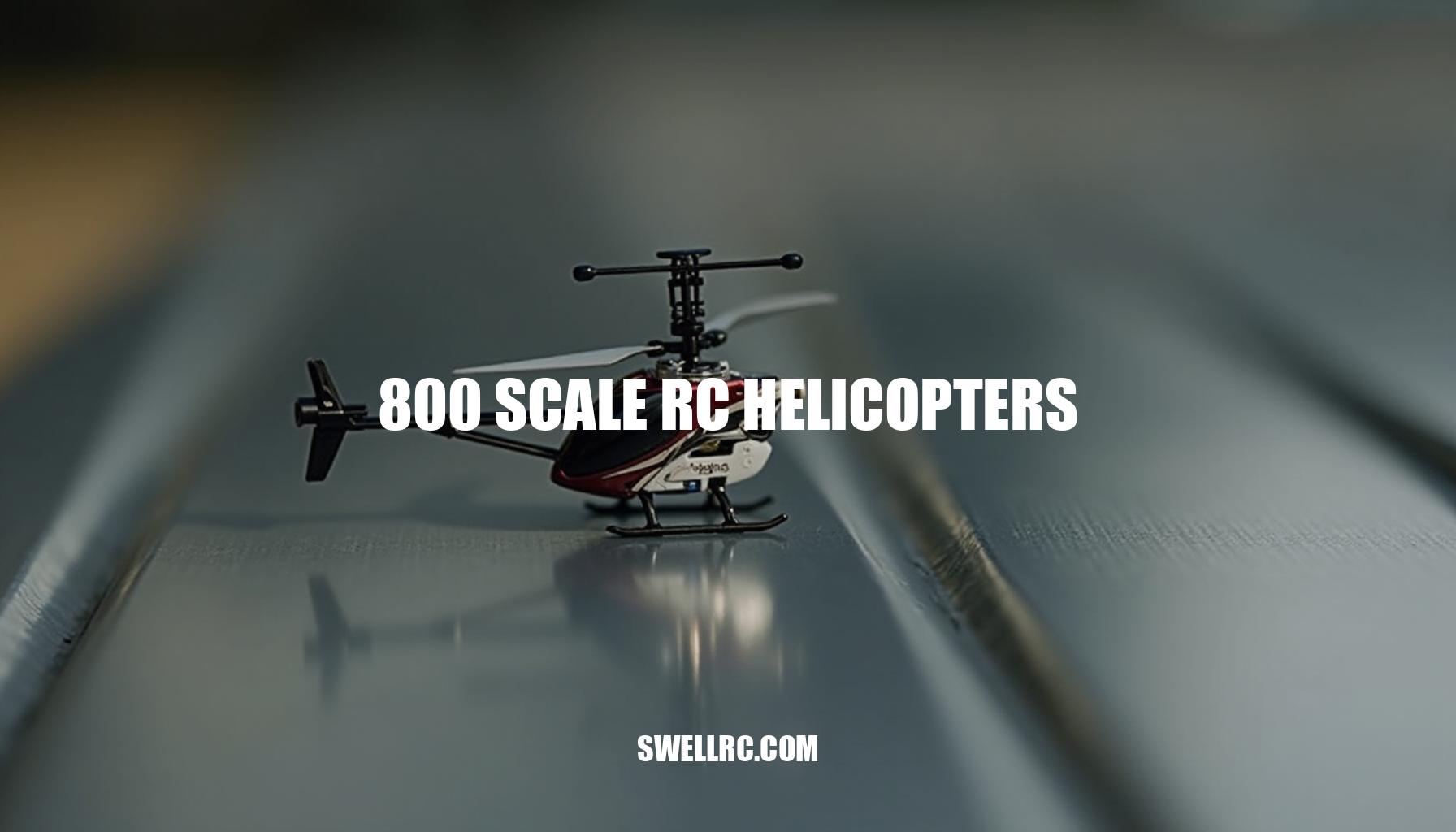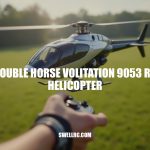Mastering 800 Scale RC Helicopters: A Journey of Precision and Patience
The first time I stood beside an 800 scale RC helicopter spool-up, the rotor wash felt like a small thunderstorm rolling across the field. The size, the presence, the sound—everything about these machines hooked me instantly, and I just had to dig into this world. In RC terms, “800 scale” (often called 800 size) refers to helicopters built around roughly 800 mm main blades, resulting in a rotor diameter approaching 1.8–2.0 meters—massive compared to park-fly models.
If you’re wondering how big is an 800 size RC helicopter, think of it as large RC helicopters that bring an impressive presence to the skies.
The craftsmanship, the engineering, and the precision you feel on the sticks make 800 scale RC helicopters a category of their own. These RC helicopter scale models aren’t just toys; they’re sophisticated machines designed for enthusiasts who demand top-tier performance. Their RC flight performance is a blend of power and finesse, offering a flying experience that smaller models simply can’t match.
For newcomers curious about 800 scale RC helicopters, understanding their size and capabilities is key to appreciating what makes them special.
From specs and setups to performance insights and standout scale builds, these large RC helicopters offer a thrilling and immersive entry into advanced RC flying. In this guide, I’ll share everything you need to know so you can decide if these giants belong in your hangar.
Understanding the Power and Scale Behind 800 Size RC Helicopters
The 800 class RC helicopter is defined by several key characteristics that set it apart from smaller models. Typically, it features 800 mm main blades which contribute to a rotor disc diameter nearing 1.8–2.0 meters. This scale increase significantly impacts the torque demands and blade inertia, requiring robust power systems often running on 12S to 14S LiPo packs paired with high-torque, low-kV brushless motors.
Flight weights commonly range between 6–10+ kg, demanding precision in setup and preflight checks to ensure stable and safe operation.
To put these specs in perspective, here’s a quick comparison of common RC helicopter sizes:
| Class | Rotor Diameter | Flight Weight | Power Setup | Typical Flight Duration |
|---|---|---|---|---|
| 450 | ~700–720 mm | ~0.8–1.2 kg | 3–6S LiPo | 4–7 min (sport) |
| 600 | ~1.2–1.35 m | ~3–4 kg | 6–10S LiPo | 5–8 min |
| 700 | ~1.5–1.6 m | ~4.5–6.5 kg | 12S LiPo | 5–8 min |
| 800 | ~1.8–2.0 m | ~6–10+ kg | 12–14S LiPo | 6–12 min (style-dependent) |
When considering scale helicopter fuselage and rotor diameter, the 800 class delivers a more authentic flying experience that closely mimics full-scale behavior. Larger size classes like 800s handle wind with greater authority, offer better visual orientation, and carry a true scale presence in the sky. This makes them excellent choices for complex models such as tandem heavy-lifters, where multi-rotor-disc presence and stretched fuselage designs are better appreciated at a larger scale.
For example, the Boeing-style tandem platform showcased here https://www.swellrc.com/boeing-ch-47-chinook-rc-helicopter/ is a perfect illustration of what 800 class models can offer.
Overall, scaling up to the 800 size class means managing increased torque loads, inertia, and flight weight, which demands careful tuning and respect for the added momentum. Compared to 450s or 700s, 800s feel calmer and more stable in the air but require non-negotiable preflight preparation to harness their full potential.
The Craftsmanship and Technology That Define These Giants
Big airframes demand big engineering to achieve optimal performance. Typically, these composite airframes consist of carbon fiber plates paired with CNC-machined aluminum bearing blocks and motor mounts. The use of carbon fiber rotor blades and plates not only keeps weight in check but also maintains the rigidity necessary to prevent resonance under heavy blade loads.
Powering these helicopters is a high-torque, low-kV brushless motor coupled with a high-voltage ESC (HV ESC), often rated between 120 and 200 amps.
Control is managed via advanced flybarless systems (FBL), which handle stabilization and tail authority with precision. Achieving the best flight results depends on a combination of meticulous mechanical setup and fine-tuned electronic adjustments. For those seeking a refresher on transmitter technology, protocols, and programming nuances, this guide to RC helicopter remote control basics offers an excellent foundation.
Interestingly, the feel of the transmitter and the tuning parameters of the flybarless system scale notably with helicopter size.
Smaller models like the Hero RC H911 produce quick, light control inputs, making them ideal for beginners. Conversely, entry-level coaxials such as the Double Horse 9101 provide even more forgiving flight characteristics but do not match the agility and control authority of collective-pitch designs.
Stepping up to larger models, such as 800-class helicopters, pilots experience smooth and deliberate precision. These helicopters typically operate at lower head speeds compared to the 3D 700 class, utilize wider blade chords to enhance lift, and require dialing in of exponential (expo) settings and banked gains for authentic scale realism.
- Tips from testing:
- Secure a rigid tail assembly to enhance control stability.
- Reduce vibration at its source using true shafts and balanced carbon fiber rotor blades.
- Maintain neat wiring to protect sensitive FBL sensors and ensure reliable transmitter compatibility.
Iconic Models and Big-Scale Legends
My journey kept circling back to a handful of showstoppers that define what 800 scale can be. These big-scale replicas of iconic helicopters truly set the bar for craftsmanship and performance, highlighting the finesse possible with an 800 scale helicopter fuselage.
- Large-Scale Chinook: Tandem rotors at big scale deliver pure theater in the sky. This tandem rotor RC helicopter’s detailed design and flight dynamics perfectly capture the essence of the real aircraft. Check out this large-scale Chinook build overview.
- Airwolf Bell 222: For fans of cinematic presence, the Airwolf lineage in 1/3.5 scale nimbly nails the curves and stance. This model’s scale helicopter fuselage is meticulously crafted to bring the iconic RC helicopter model to life. More details here.
- AH-64 Apache: The Apache’s stance, rotor disc loading, and tail authority feel right at larger size. Its realistic flight characteristics make it a standout among iconic RC helicopter models. See this example at Horizon Hobby AH-64 Apache.
- Pushing the Envelope: To get a sense of size extremes and what’s technically possible, this roundup is a fascinating rabbit hole. It showcases the largest RC helicopters you can buy, emphasizing how craftsmanship and technology combine for impressive scale helicopter fuselage designs. Explore it here.
These projects emphasize craftsmanship—flush windows, rivet detail, scale landing gear, and lighting—that elevate the model beyond mere replicas. Their flight characteristics lean toward smooth, realistic maneuvers: wide figure-eights, tidy orbits, and measured approaches. That’s where 800 scale shines—suspending disbelief at 200 feet up with remarkably realistic flight performance.
Performance, Setup, and Flight Experience
When setting up your 800 size helicopter setup guide, start mechanically by squaring the head, centering servos, and leveling the swash plate at mid-stick; ensure zero collective at mid-stick and verify equal pitch range in both directions. For Flybarless (FBL) tuning, begin with a conservative preset: increase main gain until you detect minimal oscillation, then reduce slightly. Remember, tail precompensation and governor gain are crucial when operating with heavy blades.
Regarding battery configuration, 12S to 14S setups are common among scale pilots, with 12S 8000 to 10000 mAh packs providing significant power reserves. Always monitor ESC temperature and analyze current logs to select appropriately sized packs for your flying needs.
Calibrating your gyro and controlling vibrations is vital. Balance both main and tail blades, true the main shaft, and check tail hub and grips closely. Keeping wiring runs short and secured helps minimize signal interference and mechanical vibrations.
For first-time large-scale pilots, it’s recommended to fly in calm weather as big rotor disks react differently to gusts than smaller 450 models. Use a spotter, set a flight timer, and maintain a generous safety buffer. Starting with lower headspeeds offers both a realistic scale feel and longer flight endurance.
Practice smooth collective management to avoid sudden energy surges from large blades, and log every flight detail—temperatures, mAh consumption, and setup tweaks.
| Performance Aspect | Typical Outcome |
|---|---|
| Hover Stability | Very high due to big disc area and lower headspeeds |
| Range | Standard 2.4 GHz links often surpass visual range; maintain conservative line-of-sight flying |
| Flight Endurance | 6–12 minutes, dependent on headspeed, weight, and pilot style |
| Payload/Lift | Excellent capacity for lighting systems, retracts, and scale accessories |
From extensive test sessions, 800 helicopters feel extremely planted even in breezy conditions; however, crosswinds can impose additional loading on the tail surfaces. Maintain forward airspeed during approach phases and avoid hard collective inputs close to the ground to preserve smooth control and avoid stressing components. These insights into RC flight performance and setup nuances ensure your 800-class heli performs reliably with optimized power and control.
Community, Maintenance, and the Joy of Scale Aviation
The big-scale RC helicopter scene thrives on shared knowledge found across various RC helicopter websites, offering valuable insights like build logs, paint techniques, and essential setup files. If you want a curated on-ramp to active community forums, vendor catalogs, and trusted knowledge hubs, keep this resource handy: https://www.swellrc.com/rc-helicopter-websites/.
When it comes to operational excellence, my maintenance checklist is essential for every flight. It includes:
- Fasteners: Apply blue threadlocker where metal meets metal, and recheck torque after the first 3–5 flights to ensure reliability.
- Drivetrain: Inspect main and tail gears, belts, or torque tube gears regularly; listen carefully for any pitch changes that could indicate wear.
- Bearings: Perform spin-tests and replace bearings at the first signs of notchiness or excessive heat to maintain smooth operation.
- Blades: Balance and track blades meticulously; store them separately to avoid warping and to ensure peak performance.
- Linkages: Achieve zero slop on the swashplate and tail pitch slider, verifying smooth travel for precise control.
- Power: Properly cycle LiPo batteries, store them at approximately 3.8V per cell, and log internal resistance (IR) values monthly to prolong battery life and safety.
- Electronics: Verify failsafe settings and conduct range tests before every new field day to avoid in-flight surprises.
The real joy of mastering RC helicopters lies in the ritual.
You roll a gleaming fuselage onto the pad, run a deliberate preflight, and lift into a stable hover that looks like it’s right out of a movie set. Mastery here demands equal parts patience, precision, and commitment to routine. Being part of an engaged community makes the journey more rewarding and accessible.
Conclusion: What Flying an 800 Scale RC Helicopter Taught Me
Researching and flying 800 scale RC helicopters has significantly sharpened my understanding of aerodynamics, inertia, and the nuanced control feel that makes piloting truly immersive. The blend of carbon fiber components, precision CNC metalwork, and cutting-edge FBL (Flybarless) stabilization systems creates a machine that rewards careful setup with buttery, scale-perfect flight. This hands-on experience with customizing large RC helicopters has elevated my appreciation for professional-grade setups and the meticulous attention to detail required to maximize performance and scale realism.
For enthusiasts diving into advanced RC aviation, these aircraft serve as an inspiring reminder of why we fell in love with the hobby initially: the craft itself, the passionate community, and the unparalleled thrill of watching a faithful replica carve across the sky. Whether you’re assembling RC model kits or upgrading your fleet, a methodical approach is key.
- Explore high-quality references and tutorials to build your knowledge base.
- Start with incremental customizations to hone your skills.
- Fly responsibly and respect local regulations to ensure safety and longevity of your models.
Your first mellow pass at eye level will undoubtedly make every late-night build session, every adjustment, and every flight test absolutely worth it.
Frequently Asked Questions
- What does “800 scale” mean in RC helicopters?
It typically refers to helicopters designed around 800 mm main blades, yielding a rotor diameter near 1.8–2.0 meters. It’s a size class, not a strict fuselage scale ratio, and implies heavier airframes, larger power systems, and more deliberate flight characteristics than smaller classes. - How large is an 800 scale RC helicopter?
Most 800s span roughly 1.8–2.0 meters in rotor diameter with fuselages around 1.5–2.0 meters long depending on the model and whether a scale fuselage is installed. - What are the best 800 scale RC helicopter models available?
Standout examples include large-scale tandems (e.g., Chinook-style builds), cinematic Bell 222/Airwolf variants, and military replicas like the AH-64 Apache. The “best” depends on your goal: pure scale realism, gentle sport flying, or payload for lighting/retracts. - Are 800 scale RC helicopters suitable for beginners?
Generally no. Their mass, momentum, and setup complexity favor experienced pilots. Newcomers should start with smaller, more forgiving collective-pitch or coaxial models, then step up progressively as skills and build experience grow. - How much does an 800 size RC helicopter cost?
Expect roughly $1,500–$4,000+ for an airframe with quality electronics. Adding a detailed scale fuselage, lighting, and retracts can push the total well beyond $3,000–$6,000 depending on components and finish. - What power source do large RC helicopters use?
Most modern 800s are electric, running 12S–14S LiPo batteries with high-voltage ESCs and low-kV brushless motors. Some super-scale projects may use gas or turbine power, but electric is the norm for reliability and cleanliness. - How do you maintain and store a large-scale RC helicopter?
Use threadlocker on metal fasteners, inspect gears and bearings regularly, balance blades, and verify FBL/tail settings. Store LiPos at 3.8V/cell and keep blades and fuselages in dry, temperature-stable conditions to prevent warps and corrosion. - What’s the difference between 700 and 800 size RC helicopters?
An 800 has a larger disc (about 10–20% more diameter), higher mass, and typically lower headspeed for scale flight. It feels more stable and visually readable at distance but requires more power, space, and careful momentum management than a 700.



